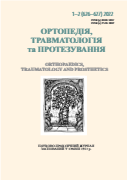Complex rehabilitation treatment after knee arthroplasty
DOI:
https://doi.org/10.15674/0030-598720221-212-19Keywords:
Rehabilitation, knee arthroplasty, restore joint function, massage, physical exercisesAbstract
Knee arthroplasty can significantly improve the quality of life of patients with knee osteoarthritis. About 20 % of patients after
knee arthroplasty unsatisfied with surgical treatment results. One of the factors that reduces the unsatisfactory results is the use
of new rehabilitation technologies. Objective. Investigate the feasibility and effectiveness of the proposed rehabilitation system within
2–3 months after knee arthroplasty. Methods. A prospective study of two groups of patients with osteoarthritis after knee arthroplasty
was conducted. The group БР consisted of 28 patients who did not undergo special rehabilitation treatment. The group Р consisted
of 30 patients who underwent special rehabilitation treatment in the hospital within 2–3 months after surgery. The groups were comparable
in terms of age and body mass index. Flexion and extension angles of the operated knee were measured in patients of both
groups within 2–3 and 5–6 months after surgery. The course of special rehabilitation treatment included: massage of the muscles
of the lower back, buttocks, thighs, leg and foot on the operated side; performing special physical exercises twice a day for
two weeks. Methods of non-parametric statistics were used to process the results. The statistical significance of the differences for
unrelated samples was checked using the Mann-Whitney U-test (CMU), for the connected ones, the Wilcoxon test (CV). Results.
After a course of rehabilitation, in group Р the flexion angle rate increased 1.3 times and amounted to 90° (90°; 100°) (КВ, р < 0.01).
In group БР during the same period the flexion angle rate underwent a partial regression, amounting 100° (100°; 110°). The rate
of extension angle in both groups Р did not change. But in group Р, in all patients who had a deficiency of extension angle of the operated
knee, it disappeared. In group БР, in all patients who had deficiency of extension angle of the operated knee, it decreased
slightly, but did not disappear. Conclusions. The use of proposed rehabilitation treatment within 2–3 months after knee arthroplasty
restores the volume of movements in the operated knee, reduces the risk of contracture of the operated joint (especially extension
contracture) and restores the normal stereotype of walking.
References
- National Joint Registry 18th Annual Report 2021 (n.d.). Retrieved from https://www.hqip.org.uk/wp-content/uploads/2021/11/NJR-18th-Annual-Report-2021.pdf.
- Yu, D., Jordan, K. P., Snell, K. I., Riley, R. D., Bedson, J., Edwards, J. J., … Peat, G. (2018). Development and validation of prediction models to estimate risk of primary total hip and knee replacements using data from the UK: Two prospective open cohorts using the UK clinical practice research Datalink. Annals of the Rheumatic Diseases, 78 (1), 91–99. doi:10.1136/annrheumdis-2018-213894
- Simpson, A. H., Hamilton, D. F., Beard, D. J., Barker, K. L., Wilton, T., Hutchison, J. D., … Murray, G. D. (2014). Targeted rehabilitation to improve outcome after total knee replacement (TRIO): Study protocol for a randomised controlled trial. Trials, 15 (1). doi:10.1186/1745-6215-15-44
- Walsh, M., Woodhouse, L. J., Thomas, S. G., & Finch, E. (1998). Physical impairments and functional limitations: A comparison of individuals 1 year after total knee arthroplasty with control subjects. Physical Therapy, 78 (3), 248–258. doi:10.1093/ptj/78.3.248
- Artz, N., Elvers, K. T., Lowe, C. M., Sackley, C., Jepson, P., & Beswick, A. D. (2015). Effectiveness of physiotherapy exercise following total knee replacement: Systematic review and meta-analysis. BMC Musculoskeletal Disorders, 16 (1). doi:10.1186/s12891-015-0469-6
- Petterson, S. C., Mizner, R. L., Stevens, J. E., Raisis, L., Bodenstab, A., Newcomb, W., & Snyder-Mackler, L. (2009). Improved function from progressive strengthening interventions after total knee arthroplasty: A randomized clinical trial with an imbedded prospective cohort. Arthritis & Rheumatism, 61 (2), 174–183. doi:10.1002/art.24167
- Bade, M. J., & Stevens-Lapsley, J. E. (2011). Early high-intensity rehabilitation following total knee arthroplasty improves outcomes. Journal of Orthopaedic & Sports Physical Therapy, 41(12), 932-941. doi:10.2519/jospt.2011.3734.
- Jakobsen, T. L., Husted, H., Kehlet, H., & Bandholm, T. (2011). Progressive strength training (10 RM) commenced immediately after fast-track total knee arthroplasty: Is it feasible? Disability and Rehabilitation, 34 (12), 1034–1040. doi:10.3109/09638288.2011.629019
- Frost, H., Lamb, S. E., & Robertson, S. (2002). A randomized controlled trial of exercise to improve mobility and function after elective knee arthroplasty. Feasibility, results and methodological difficulties. Clinical Rehabilitation, 16(2), 200-209. doi:10.1191/0269215502cr483oa
- Myers, T. W. (2020). Anatomy trains E-book: Myofascial meridians for manual therapists and movement professionals. Elsevier Health Sciences.
- Hungerford B., Gilleard, W. (2007). The pattern of intrapelvic motion and lumbopelvic muscle recruitment alters in the presence of pelvic girdle pain. In A. Vleeming, V. Mooney, R. Stoeckart Movement, Stability and Lumbopelvic Pain (pp.361–376). Edinburg : Churchill Livingstone.
- Korzh, M., & Staude, V. (2021). Conceptual model of patho- and sanogenesis of the sacroiliac joint osteoarthritis. ORTHOPAEDICS, TRAUMATOLOGY and PROSTHETICS, (2), 28–38. doi:10.15674/0030-59872021228-38
- Staude, V., Karpinska, O. (2018). Evaluation of changes in statographic parameters and muscle strength in patients with sacroiliac joint dysfunction after special exercises. Trauma, 19 (6), 39–49. doi: 10.22141/1608- 1706.6.19.2018.152219.
- Moffet, H., Collet, J., Shapiro, S. H., Paradis, G., Marquis, F., & Roy, L. (2004). Effectiveness of intensive rehabilitation on functional ability and quality of life after first total knee arthroplasty: A single-blind randomized controlled trial. Archives of Physical Medicine and Rehabilitation, 85 (4), 546–556. doi:10.1016/j.apmr.2003.08.080
- Li, D., Yang, Z., Kang, P., & Xie, X. (2017). Home-based compared with hospital-based rehabilitation program for patients undergoing total knee arthroplasty for osteoarthritis. American Journal of Physical Medicine & Rehabilitation, 96 (6), 440–447. doi:10.1097/phm.0000000000000621
- Lowe, C. J., Barker, K. L., Dewey, M., & Sackley, C. M. (2007). Effectiveness of physiotherapy exercise after knee arthroplasty for osteoarthritis: Systematic review and meta-analysis of randomised controlled trials. BMJ, 335 (7624), 812. doi:10.1136/bmj.39311.460093.be
- Bade, M. J., Struessel, T., Dayton, M., Foran, J., Kim, R. H., Miner, T., … Stevens-Lapsley, J. E. (2017). Early high-intensity versus low-intensity rehabilitation after total knee arthroplasty: A randomized controlled trial. Arthritis Care & Research, 69 (9), 1360-1368. doi:10.1002/acr.23139
- Staude, V., Radzishevska, Y. (2021). Influence of massage and selective gymnastics on roentgenometric parameters of spinopelvic sagittal balance in patients with sacroiliac joint dysfunction. Journal of Physical Education and Sport, 21 (Suppl. 6), 3236–3245. doi: 10.7752/ jpes.2021.s6442.
- Disequilibrium of posture as root cause for preponderance of chronic neuromusculoskeletal pain (n.d.). Retrieved from https://www.researchgate.net/publication/332353483a.
- Luchau, T. (2015). Advanced Myofascial techniques: Shoulder, pelvis, leg and foot. Handspring Pub.
Downloads
How to Cite
Issue
Section
License

This work is licensed under a Creative Commons Attribution 4.0 International License.
The authors retain the right of authorship of their manuscript and pass the journal the right of the first publication of this article, which automatically become available from the date of publication under the terms of Creative Commons Attribution License, which allows others to freely distribute the published manuscript with mandatory linking to authors of the original research and the first publication of this one in this journal.
Authors have the right to enter into a separate supplemental agreement on the additional non-exclusive distribution of manuscript in the form in which it was published by the journal (i.e. to put work in electronic storage of an institution or publish as a part of the book) while maintaining the reference to the first publication of the manuscript in this journal.
The editorial policy of the journal allows authors and encourages manuscript accommodation online (i.e. in storage of an institution or on the personal websites) as before submission of the manuscript to the editorial office, and during its editorial processing because it contributes to productive scientific discussion and positively affects the efficiency and dynamics of the published manuscript citation (see The Effect of Open Access).














